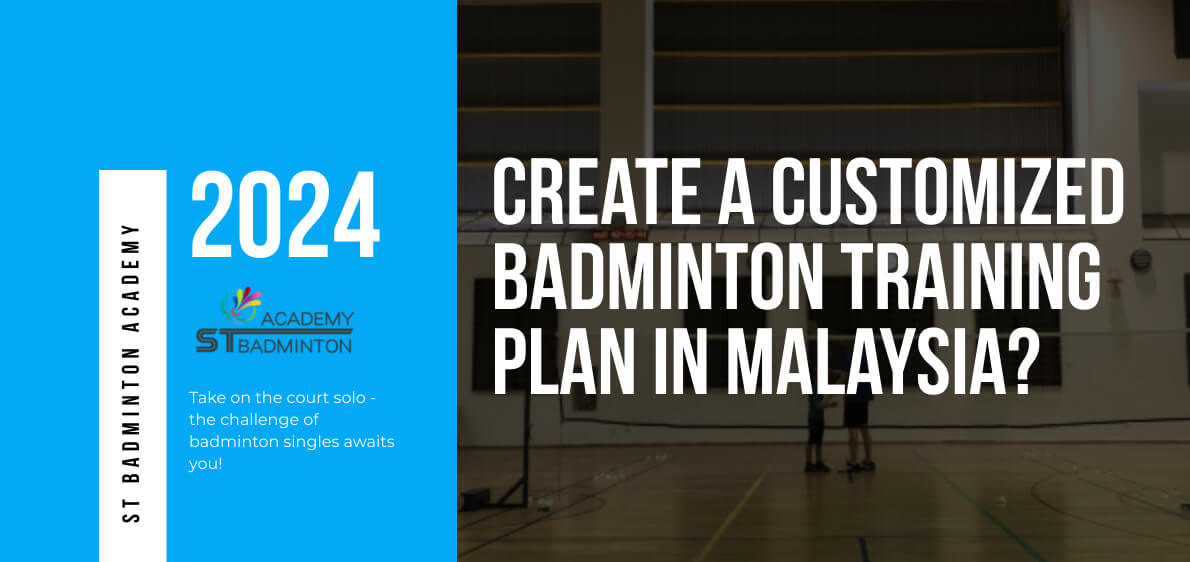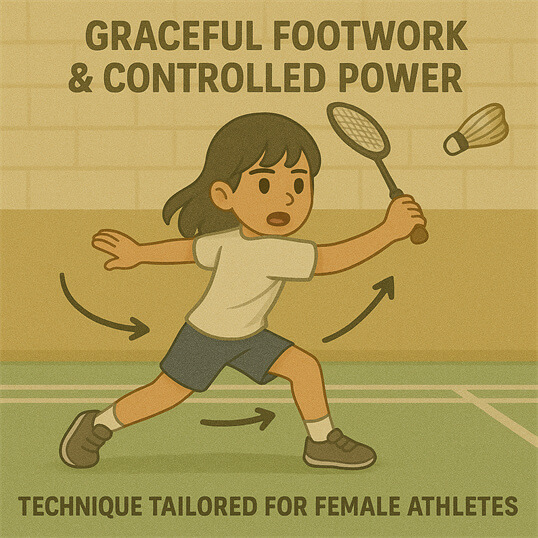Welcome to ST Badminton Academy’s badminton training in Malaysia! You’ve come to the right place! I’m a badminton training specialist and know exactly what it takes to design an effective program. With my help, you’ll be ready to take on any opponent in no time.
Creating your own tailored plan can seem daunting at first. But don’t worry – I’m here to walk you through each step of the process. From determining the type of workouts you need, to setting goals and tracking your progress – we’ll cover all the bases so you can improve your game quickly and effectively!

Determining Your Goals
Creating a customized badminton training plan requires that you examine your goals, skill level and lifestyle. Let’s start by taking a look at what it is you’re trying to achieve with this plan. Your goals should be realistic, but they should also push you out of your comfort zone.
Once these are established, factor in nutrition choices that will help fuel your body for the workouts ahead. Make sure to include plenty of rest periods as well – physical activity can take its toll if not done responsibly! Knowing how much sleep and down time your body needs is key for success here. With all of these elements in mind, we can move on to examining your skill level.
Examining Your Skill Level
Before crafting a customized badminton training plan, it’s important to first evaluate your skill level. For starters, you’ll want to assess your current strengths and weaknesses as a player so you can adequately build upon them. To get an accurate assessment of where you lie on the spectrum, try doing some rallying drills and footwork drills to gauge how well you perform when in game-like situations. Take note of any issues that arise during these tests as they will be key indicators for areas that need more focus and attention going forward.
Additionally, if possible, have someone experienced with the game observe you while playing these drills so they can provide honest feedback about what needs improvement.
This could give you invaluable insight into specific aspects of your game that require extra practice or refinement. Knowing exactly which skills need work is essential in order to create an effective training plan tailored towards your individual goals and abilities. Other than choosing a good racket and also remember to choose the best racket restring in Malaysia.
Crafting Your Workout Routine
Creating a customized badminton training plan takes preparation and dedication. Before I dive into the specifics, it’s important to address mental preparation and equipment selection. Mental preparation is key; you need to be in the right frame of mind and have an understanding of what you want to accomplish with the workout routine. This will help ensure that your time spent training is meaningful, focused, and efficient.
When it comes to selecting equipment for your workout routine, there are many avenues available depending on where or how often you intend to train. For outdoor workouts, shuttlecocks, rackets, nets, exercise bands/tubes/balls are all pieces of essential gear you should consider having at your disposal. If you’re planning on training indoors instead, then badminton shoes featuring non-marking soles should be considered as well:
| Equipment | Considerations |
|---|---|
| Shoes | – Ensure proper fit and size according to foot structure. |
| – Choose shoes with a non-marking sole for indoor courts. | |
| – Opt for lightweight construction for agility and speed. | |
| Rackets | – Select an appropriate weight based on playing style and skill level. |
| – Choose grip material (leather vs synthetic) based on personal preference. | |
| – Ensure the racket is strung properly for desired tension levels. | |
| Shuttlecocks | – For outdoor workouts, consider having shuttlecocks, rackets, nets, and exercise bands/tubes/balls at your disposal. |
| – For indoor training, badminton shoes with non-marking soles are recommended. | |
| – Feather shuttles offer greater control but require more frequent replacement than plastic ones. |
It’s also wise to keep spare equipment handy in case something needs replacing during the course of your session. With these basics covered off – let’s move onto incorporating interval training into our workout routine!
Incorporating Interval Training
Interval training is an absolute must for any badminton player looking to take their game up a notch. It can be tailored specifically to each individual’s needs and capabilities, allowing them to maximize the benefits of this powerful technique. When done right, interval training will help refine both your physical and mental focus while on court – giving you that extra edge during competitive play.
Let’s start with the basics: interval training essentially involves alternating between short bursts of intense exercise followed by moments of recovery. The key is to push yourself as hard as possible during these intense periods in order to stimulate your muscles into becoming faster and more powerful. This requires someone with enough knowledge about how much intensity is necessary for each drill, which is why it’s important to get personalized guidance from a professional or experienced coach so they can tailor drills according to your skill level.
When engaging in interval training, remember that consistency is paramount; without committing regularly, you won’t see results! Make sure to keep track of your progress along the way too – noting what worked well and what didn’t – because this type of tracking helps ensure improvement over time.
With the right approach and dedication, interval training can give you just the boost you need to reach new heights in badminton performance! Now let’s move onto building strength and stamina…
Building Strength And Stamina
Creating a customized badminton training plan starts with strengthening your body and increasing your stamina. Working on both will help you stay active throughout the game, no matter how long it lasts. Eating habits can play an important role in this, so I recommend having meals that are high in protein and rich in healthy fats to give you natural energy boosts during practice sessions.
Fitness levels also need to be taken into account when developing a personalized plan for success. You should begin by doing exercises targeting core muscles and legs as they are essential for dynamic movements in badminton like lunges, jumps, and sprints. Performing these drills regularly will allow you to move better around the court and improve your overall performance.
Building up endurance is just as crucial as strength-training; however, conditioning workouts must not exceed more than two hours per day or else fatigue may occur too soon which would hinder progress significantly. The focus here should be on performing cardio exercises such as running, swimming or cycling at intervals of moderate intensity and varying lengths of time to slowly build up your aerobic capacity over time.
Now that we have established the basics of physical preparation let’s move on to practicing proper technique…
Practicing Proper Technique
I can’t stress enough the importance of proper form when it comes to badminton. It’s vital that you learn how to position yourself and move on court in order to get the most out of your training sessions. To help with this, I recommend doing drill variations which focus on different parts of footwork. This will give you an opportunity to practice moving in multiple directions while maintaining good posture throughout.
Furthermore, drills should also include various techniques such as clears, smashes and drops so that you become comfortable using all these shots during a match-like situation. Make sure to pay close attention to keeping your head still after each stroke and being aware of where your racket is going at all times. Once you have mastered correct positioning and technique for every shot, then you are ready to take them into a game scenario!
It’s important not just to focus on improving your skills but also making time for recovery too. Giving your body some rest between matches or practices will allow it heal properly before getting back onto the court again.
With adequate rest, you’ll be able to perform better and reduce any risk of injury due to overtraining. Taking a break will also ensure that both mind and body remain fresh so that you’re always feeling motivated and energized when playing badminton! As we transition into discussing making time for recovery, let’s consider what strategies best suit our particular needs…
Making Time For Recovery
As a badminton training specialist, I know that learning to rest is one of the most important aspects when creating a customized training plan. Rest not only ensures your body has time to recover and build up strength but also prevents injury or burnout. It’s crucial to listen to your body during this process – if you feel like you need an extra day off, take it!
The following are five key things to keep in mind when incorporating recovery into your personalized badminton training program:
| Key Recovery Aspect | Description |
|---|---|
| Prioritize Proper Sleep | Ensure adequate sleep by going to bed at a reasonable hour and getting the recommended amount of hours for recovery. |
| Incorporate Light Stretches | Include light stretches before and after each practice session to enhance flexibility and reduce muscle soreness. |
| Take Regular Breaks | Schedule regular breaks during practices for hydration and additional stretching to prevent fatigue and improve recovery. |
| Include Rest Days | Integrate days with no physical activity into your weekly routine to allow the body time to rest and recover. |
| Avoid Overexertion | Be mindful not to push yourself too hard; sometimes, less intense training can be more beneficial for overall recovery. |
These tips will help you properly manage fatigue levels so that you can perform optimally on game day without risking injury or burnout. Taking the time for recovery allows for growth both physically and mentally; therefore, tracking your progress over time becomes even easier!
Tracking Your Progress
Once you’ve invested the time to make recovery a priority, it’s important to track your progress. Developing accountability and reviewing results is key in reaching any fitness goal – especially when playing badminton. A great way to ensure success on your journey is to create milestones that are both achievable and measurable so you can easily evaluate your performance over time.
Setting up goals with specific dates of completion will give you something tangible to work towards. This could be anything from running three miles by the end of the month or achieving an overhead smash shot five times out of ten attempts. Whatever works best for you! Keeping records of each milestone met will help keep yourself motivated while training, as well as provide an opportunity for reflection and self-improvement afterwards.
It’s also helpful to get feedback from someone who has knowledge about the sport such as a coach or mentor. Having another professional opinion can not only guide you in better understanding what areas need improvement but will also validate how far along you’ve come since starting your journey. Ultimately, this extra set of eyes can offer invaluable insights into where adjustments should be made if needed – ultimately leading to more successful outcomes during gameplay and beyond!
Frequently Asked Questions

How Often Should I Practice?
As a badminton training specialist, I always emphasize the importance of practicing regularly to my students. Whether you’re just starting out or an experienced player looking to improve, it’s essential to practice at least three times per week. That way your body and skills stay in shape. To maximize progress, combine strength training with shadow drills for best results. It’s also important not to overdo it – too many long sessions can lead to burnout and injuries. Aim for shorter but more frequent practices instead!
What Type Of Equipment Do I Need?
When it comes to badminton training, you’ll need the right equipment if you want to make your customized plan a success. Investing in quality rackets and shuttlecocks is essential for any player looking to improve their game.
You should also have access to sport-specific drills that target key areas of improvement, as well as strength building exercises tailored specifically to this high-intensity sport. By having all these pieces together in your arsenal, you’ll be able to create a personalized training program that will help take your game to the next level!
What Is The Best Way To Warm Up Before A Training Session?
It is essential to warm up before any badminton training session. This helps to gradually increase the body’s temperature and prepare muscles for physical activity. Stretching exercises are a great way to improve flexibility, reduce muscle soreness and prevent injuries during training sessions.
Incorporating consistent practice of basic stretching exercises such as arm circles and leg swings into your daily routine will help you get into the habit of warming up properly prior to each session. Additionally, a few sets of dynamic stretches like lateral lunges or high knee runs can be incorporated in order to further loosen tight muscles and joints that may cause injury if not warmed up well beforehand.
Is There A Particular Diet I Should Follow?
When it comes to badminton training and performance, diet plays an important role. To get the most out of your training sessions, you’ll need to ensure that your nutrient needs are met with a balanced diet. Eating plenty of fruits and vegetables, whole grains, lean proteins, healthy fats and avoiding processed foods will help fuel your body for optimal performance.
Additionally, make sure to stay hydrated by drinking at least 8 glasses of water per day. Doing so can help improve your energy levels during practice and competition.
Are There Any Specific Drills Or Exercises I Should Focus On?
Creating a custom badminton training plan is like building a house. You need to focus on the foundations first, which are skill building and mental preparation.
Drills such as shuttlecock running, shadow-play and footwork drills can help you hone your physical skills while visualizations can be used to work on your mental preparedness. To make sure your game reaches its full potential, it’s important to include these elements into your training regimen in order for you to reach that championship level performance!
Conclusion
Creating a customized badminton training plan doesn’t have to be complicated. All you need is an understanding of how often and what type of equipment is needed, as well as the best way to warm up before each session. Additionally, following a healthy diet that supports your physical needs will help ensure success in reaching your goals.
Remember: practice makes perfect! Dedicate yourself to regular, consistent practice and focus on specific drills or exercises that target weak areas in your game. With dedication, hard work and perseverance, you can create a personalized training program tailored to improving your skillset and achieving maximum performance.





